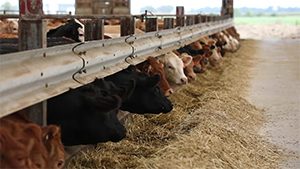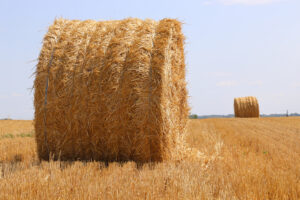Spinning Straw Into Gold
This article written by Dr. Reynold Bergen, BCRC Science Director, originally appeared in the October 2019 issue of Canadian Cattlemen magazine and is reprinted on the BCRC Blog with permission of the publisher.
The rumen allows cattle to digest fiber that chickens, pigs and humans can’t, and produce high quality beef protein from feed and land that otherwise wouldn’t produce food. Understanding the rumen better is the key to improving feed efficiency and improving cattle’s ability to convert fiber to protein.
There’s as much energy in straw as grain – burning a ton of either straw or grain generates the same amount of heat. But cattle can’t access all the energy in straw.Grain is mostly starch. Starch is a long chain of identical sugar (glucose) molecules connected by simple links that rumen microbes can easily break using a few enzymes. That’s why feedlot cattle digest and convert grain-based diets so rapidly and efficiently. In contrast, straw contains cellulose, hemicellulose, pectin and lignin fibers. These contain many different molecules (not just glucose) connected by complex links that are much tougher (and require many more enzymes) for microbes to break. That’s why cows can’t be wintered on straw alone.
Rumen microbes are sophisticated. They don’t just leak enzymes into the rumen and hope the enzymes reach the right spots, release nutrients, and wait for the nutrients to float back so they can absorb and use them. In reality, microbes build complex structures that resemble the space shuttle’s “Canadarm”, with enzymes mounted along it. The enzyme at the far end attaches to the feed particle and digests a specific linkage. It breaks off a small piece and passes it to the next enzyme. That enzyme breaks it down further and passes it along, and so on, until small molecules (e.g. sugar or ammonia) arrive at the microbe’s surface. The microbe absorbs these molecules and converts them to volatile fatty acids or microbial protein that the animal can use.
Cattle can’t fully digest straw because rumen microbes don’t produce all the enzymes needed to digest some of the complex linkages in fiber. Commercial enzyme supplements have been marketed, but often contain many of the same enzymes that rumen microbes already produce.
Nature may have the enzymes we need. For instance, year-old straw is more digestible because fungi and other microbes have been pre-digesting those complex fibers. A research team led by Agriculture and Agri-Food Canada’s Tim McAllister is collaborating with Concordia University’s Adrian Tsang to find fungal enzymes to help improve straw digestibility. This team recently published Identification of novel enzymes to enhance the ruminal digestion of barley straw (Bioresource Technology 260:76-84).
What They Did:

Enzymes from four different fungi were mixed with rumen enzymes from cattle that had been fed a 70% straw diet. Ground barley straw was added to each of the four mixtures to determine which fungus produced enzymes that could help the rumen enzymes release the most glucose from straw. Then, all the enzymes from the best fungus were extracted and run through a lab procedure to separate the fungus’s different “Canadarm” enzyme assemblies from each other. Each enzyme assembly was individually mixed with ground straw again and glucose production was measured. Finally, the assemblies that produced the most glucose were taken apart and analyzed to determine which individual enzymes were involved, what their functions were, and whether or not similar enzymes already exist in the rumen.
What they Learned:
The fungus that helped the rumen enzymes produce the most glucose contained fifteen different “Canadarm” enzyme assemblies. When tested individually, three of these assemblies produced much more glucose than the rest. Some of the enzymes in these three assemblies were related to enzymes already produced by rumen microbes. But some of these fungal “Canadarm” assemblies contained new enzymes that can break down fiber linkages that rumen enzymes can’t.
What it Means:
If I talk fast and wave my hands, the next steps sound simple… just find the fungal genes that code for these unique fiber digestion enzymes, clone the genes into bacteria and express them to produce the enzymes on an industrial scale, purify the enzymes, and manufacture an effective feed enzyme additive. But it’s a long distance from theoretically possible to practical reality. Many more years, enzymes, lab work, digestibility trials, animal feeding trials and much trial and error will be needed before any cost-effective enzyme supplements hit the market.
Most of the research that Canada’s beef producers fund through the BCRC are designed to tweak or refine existing practices or technologies. In contrast, efforts to find new enzymes that improve straw digestibility are many years and dollars away from commercial reality. But this “basic” research pipeline is generating new knowledge about how nature evolves ways to derive energy from complex fiber. This may lead to whole new technologies and production practices for the beef industry.
|
This “basic” research pipeline is generating new knowledge about how nature evolves ways to derive energy from complex fiber. This may lead to whole new technologies and production practices for the beef industry. |
Improving feed efficiency and the feed supply through utilization of alternative feeds, feeding and production systems will contribute to the National Beef Strategy goal of increasing production efficiencies by 15%. The Strategy explains why the Canadian Beef Cattle Check-Off increased from $1 to $2.50 per head in most provinces (with approximately 75 cents allocated to the Beef Cattle Research Council), and how it is being invested.
The Beef Research Cluster is funded by the Canadian Beef Cattle Check-Off and Agriculture and Agri-Food Canada with additional contributions from provincial beef industry groups and governments to advance research and technology transfer supporting the Canadian beef industry’s vision to be recognized as a preferred supplier of healthy, high quality beef, cattle and genetics.
Click here to subscribe to the BCRC Blog and receive email notifications when new content is posted.
The sharing or reprinting of BCRC Blog articles is typically welcome and encouraged, however this article requires permission of the original publisher.
We welcome your questions, comments and suggestions. Contact us directly or generate public discussion by posting your thoughts below.
